Physicists and Physicians: Five centuries of co-operation
- Date
- 15 Apr 2014
- Start time
- 7:30 PM
- Venue
- Tempest Anderson Hall
- Speaker
- IPEM

Physicists and Physicians: Five centuries of co-operation
A lecture by Professor Francis Duck, MBE, University of Bath
A joint event organised by YPS in assocaition with the Institute of Phyisics and Engineering in Medicine (IPEM)
Medical physicists play a vital role in delivering healthcare. They keep us safe from radiation; tailor treatments to patients; and research and develop better clinical techniques and new medical devices. If you ever had a scan, x-ray, implant, laser surgery or radiotherapy, a medical physicist will have helped you. And yet their importance is often overlooked.
This lecture will celebrate the lives and contributions of those who have understood that the principles of physics are essential to clinical medicine. Drawing on his recently published history of medical physics as well as his own career in medical imaging, Professor Duck will trace the development of the discipline over 500 years: from its origins in Renaissance Italy to current developments and future prospects.
Report
Professor Duck took as his starting point the meeting in Pisa in1656, when anatomist Malpighi inspired mathematician and physicist Borelli to write his book, De motu animalium, describing the physics involved in movement. In 18th-century France Louis XVI established the Société Royale de Médecine, which included among its members Benjamin Franklin and Lavoisier. After the revolution, the new Ecole de Santé introduced medical physics into the syllabus. In the 19th century the use of science in medicine captured the attention of the British Association for the Advancement of Science. The inaugural meeting at York considered papers on Crystalline lenses in optics and medicine and Atmospheric pressure on the animal frame, while at the 1864 meeting in Bath, papers were presented demonstrating equipment to record the trace of the pulse, and classifying food as either heat producing or tissue forming. By the end of the 19th century, the use of electricity in medicine was gaining interest, especially the use of x-rays. The 20th century saw a blossoming of techniques for imaging and for treating illnesses. Investigations using CT, MRI, ultrasound, and magnetic resonance have become familiar, and forty percent of cancer cures now involve radiotherapy.
Margaret Leonard